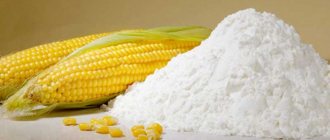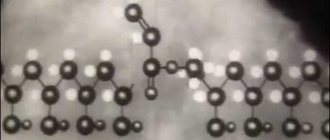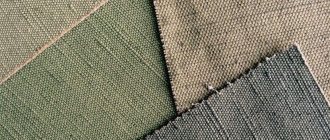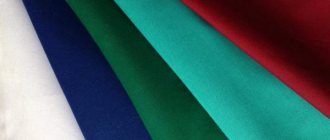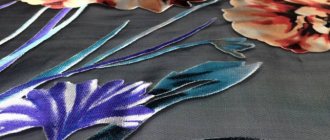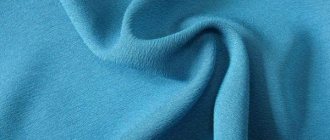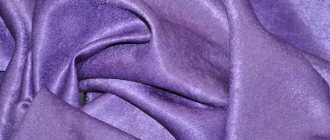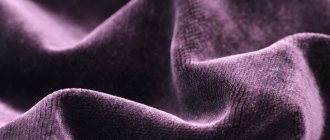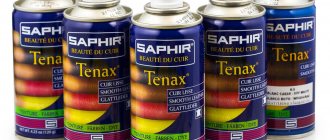Modern technologies have affected all spheres of human life. The best example of how they are developing is the textile industry: humanity has learned to produce synthetic fabrics.
Viscose is a type of artificial fabric made from cellulose. This type of canvas is obtained by processing wood raw materials. Synthetic fabrics are made from polymers obtained through chemical reactions. The raw materials for the material are petroleum products, coal, gas. As a rule, sportswear or things necessary for use in extreme situations are made from synthetic fabrics.
Advantages and disadvantages of synthetic fabrics
Synthetic material has its advantages and disadvantages. Despite the abundance of natural fabrics, there are a number of advantages of synthetic material.
- Lightness of fabric. Unlike natural materials, synthetic fabric is lightweight.
- Durability. Clothing made from synthetic material is less susceptible to wear and tear and retains color fastness well. This is achieved through special processing of matter. That's why things can be worn for a long time without fear of them fading. However, some species deteriorate when exposed to ultraviolet rays.
- Fast drying. Almost all synthetic materials do not absorb much moisture, and drying does not take much time.
- Price. The low price of the material is achieved due to the low cost of the original product. It is profitable for enterprises to produce such fabrics, which is why their production volumes are increasing every year.
The industry is developing every day. Fabric manufacturers can change the characteristics of the fabric taking into account the wishes of large customers.
The biggest disadvantage of such materials is that they can negatively affect health. Synthetic fabric becomes electrified due to the fact that it accumulates static electricity. A person may have an individual tolerance for this tissue. It practically does not absorb moisture, therefore, it is not a very hygienic material. Synthetics are not breathable, so underwear made from polyester or spandex is not very comfortable for everyday use.
On the other hand, in bad weather, synthetic fabric will be extremely useful - it can protect a person from precipitation better than natural fabric.
There are no shortcomings
Although the modern chemical industry is developing by leaps and bounds, trying to improve the properties of synthetic materials, it is still not possible to get rid of some negative aspects.
List of the main disadvantages of synthetics:
- Reduced hygroscopicity. Synthetic clothing does not absorb moisture well, heat exchange is disrupted, and the human body sweats.
- Absorption of odors. Some types of fabrics are capable of accumulating unpleasant odors and spreading them until the next wash.
- Possibility of allergies. People prone to allergic reactions may experience skin irritation after contact with synthetics.
- Toxicity. Unfortunately, cheap synthetic materials are not always safe for health. It is not recommended to buy such clothes, especially for small children.
While clothes made from 100% synthetics may cause understandable concerns among buyers, adding chemical fibers to natural fabrics only improves their properties, making them safer and more environmentally friendly.
Important! Materials made from mixed fibers are elastic, do not wrinkle when worn, do not require ironing, and do not cause allergies in people with sensitive skin.
Production Features
The first patent for the production of synthetic fabric was registered back in 1930. First, they learned to isolate polyvinyl chloride fibers, then German scientists were able to obtain polyamide. This material became known as nylon. Its production was put on the assembly line only in 1939.
In the Soviet Union, synthetic clothing began to be produced only in the late 60s. At first it was simply a cheap substitute for natural fabric. Only many years later they found proper use for it: they began to produce workwear that was distinguished by high wear resistance characteristics and could protect a person from adverse environmental factors.
Artificial and synthetic materials differ in the specifics of production, as well as in the cost of raw materials. Synthetics do not require large expenses. When making fabric, fiber is synthesized from low molecular weight compounds. To produce a material, the raw material must be melted or dissolved. Afterwards, the thread can be separated from the viscous material. The thread can be single, complex or twisted in the form of a tourniquet. Also, individual parts of clothing and shoes can be made from the molten material.
What are synthetic textiles made from?
Today there are many types of synthetic fibers. Specialists are constantly producing new varieties of material. However, for convenience, they are divided into two groups, each of which has its own characteristics.
Carbon chain synthetics
Hydrocarbons are used in its production. This variety combines the following list of fabrics:
- polyethylene;
- polyacrylonitrile;
- polypropylene;
- polyvinyl chloride;
- polyvinyl alcohol.
Heterochain synthetics
This type of fabric is made not only from hydrocarbons, but also from other chemical elements. These can be nitrogen, chlorine, fluorine. Elements help improve the characteristics of matter.
This group includes the following fabrics:
- polyester;
- polyurethane.
- polyamide.
Thanks to these substances, things based on heterochain synthetics add additional qualities to the usual characteristics, which are indispensable when sewing workwear.
Image is the basis of modern collective art
Synthesized forms of art, derived from fine art, dominate the modern system of video culture. Synthetic arts and image have a close connection through the monitor or screen. Both one and the other are a picture (image), only constantly moving. The screen is a direct successor of fine art, thanks to the continuous evolution of modern computer technology.
Today, a person in a rapidly changing world is in a changing space of visual arts. And it is natural that introduction to culture and other types of creativity often takes place through the screen.
With each subsequent round of the technological revolution, new unusual ideas, new subtypes of art appear, and with them customs and traditions change.
Digital art (computer or digital) is a creative human activity. It is organized with the help of computer or information technologies, through the use of which a digital product is obtained.
Types and names of synthetic fabrics
So, the textile industry at this stage of its development makes it possible to produce a variety of types of synthetic fabric. But how not to get confused in such an assortment and find out which fabric meets all the necessary criteria? Here are brief characteristics of the most popular varieties of synthetics.
- Lavsan
Has high wear resistance. The fabric does not shrink and can withstand strong temperature changes, up to + 115 degrees. Keeps its shape for a long time. The material is hard to the touch and does not allow water to pass through. The canvas is most often used in the manufacture of curtains. Much less often it is added to natural raw materials for the production of suits - this allows to increase the wear resistance of products.
- Fleece
Made from synthetic fiber. In appearance it resembles natural wool. Very soft, warm material. It is elastic and breathable. The material is easy to care for, easy to wash and clean. The main thing is that it does not need to be dried and ironed for a long time, which significantly saves time. The fabric is often used in the production of children's clothing. The disadvantage is the rapid loss of shape due to the fact that the item stretches during everyday wear. Fleece can accumulate static electricity.
- Polysatin
Made with the addition of cotton or polyester. The material has a number of advantages. It is easy to wash, does not wrinkle, does not lose shape, and has a shiny surface. It is often used in the production of bedding sets, curtains, and for furniture upholstery. Fashionable and popular bed linen “with a 3D effect” is often made from this type of fabric.
- Acrylic
This is a fabric that looks like wool, but it is much more practical than natural fiber. Retains its shape for a long time and does not allow moisture to pass through. The material is not exposed to ultraviolet rays, is easy to clean and does not shrink. It is also used in combination with wool.
Acrylic is used for sewing outerwear. In combination with wool, it is also used to make children's mattresses, since this fabric is not able to absorb water. When combined with natural fibers, it gives things strength. Acrylic does not form pellets and is able to hold its shape for a long time. However, it also has a small drawback - things made from this fabric are highly electrified. Acrylic is often added to knitting threads.
- Dyneema and Spectra
In this group, there are two types of fibers - polyethylene and polypropylene. They are the lightest in the synthetic fabric category. Such a canvas cannot be drowned in water. It is heat resistant. The material cannot be stretched and is resistant to any weather changes.
Withstands temperatures up to +115 degrees. Widely used in the production of tourist and specialized clothing, for example for fishermen, skiers, rock climbers, and hunters. The material is also used for the manufacture of underwear and hosiery. However, for this purpose, fabric made from natural fibers must be taken.
Development of the Synthetic Arts
Fiction refers to simple, one-component types of art that rely on only one material carrier of imagery. In this case, such a material carrier is the written word. But at the same time, fiction is closely related to the arts, which combine several carriers of imagery. Such multi-component arts are called synthetic.
Synthetic arts primarily include:
Are you an expert in this subject area? We invite you to become the author of the Directory Working Conditions
- theater (opera and drama), which “absorbed” literature, music, acting, painting, decorative and applied arts, etc.
- ballet - it combines music, dance, painting, sculpture, etc.
- variety art consisting of dancing, singing, acrobatics, recitation, illusionism, etc.
- circus - it combines clowning, strength gymnastics, acrobatics, dancing, and also involves representatives of the animal world in the performances.
Historically, early syntheses were a combination of rhythmic dance movements with music, song, and also elements of recitation. However, this action was not art itself, but was the so-called syncretic creativity, on the basis of which the formation of verbal art - drama, lyricism and epic - then took place.
Definition 2
Syncretism is a unity that characterizes the original, still undeveloped state of something.
Finished works on a similar topic
Course work Literature and synthetic arts 460 ₽ Essay Literature and synthetic arts 240 ₽ Examination Literature and synthetic arts 240 ₽
Receive completed work or specialist advice on your educational project Find out the cost
Initially, syncretic creativity took the form of a ritual choir. It had a magical and mythological-cult function. In ritual syncretism there was no division of persons into actors and perceivers; everyone was simultaneously a participant, a performer of an action, and its co-author. For archaic tribes, such a round dance “pre-art” was mandatory. According to the ancient Greek philosopher Plato, absolutely everyone must be able to dance and sing enthusiastically and in a variety of ways.
As artistic creativity developed, single-component arts began to acquire an increasingly important role. The development of synthetic arts was slow due to the fact that they did not create the prerequisites for the broad and free expression of the individual creative potential of the artist. This is due to the fact that the capabilities of each individual type of art included in the synthetic work were greatly limited. This explains the fact that the centuries-old history of culture is associated with the constant differentiation of different forms of artistic activity.
At the same time, in the 19th and early 20th centuries, another trend was repeatedly observed. The German romantics Wackenroder, Novalis, and then Vyacheslav Ivanov, R. Wagner and A. N. Scriabin attempted to return art to its original syntheses. For example, R. Wagner in his book “Opera and Drama” considered the departure from early syntheses as a decline in art and called for a return to them. Wagner noted a big difference between certain types of art, which, in his opinion, are limited to the type of appeal only to the imagination, and true art, which is addressed to the sensual in its entirety. According to Wagner, opera is the highest form of art in general and theatrical and dramatic creativity in particular. However, these attempts to restructure artistic creativity were unsuccessful. Single-component arts are the dominant feature of artistic culture and its undeniable value.
At the beginning of the 21st century, synthetic searches go beyond the boundaries of individual types of art, but also art in general. Now art critics believe that the idea of widespread synthesis is amateurish absurdity and extremely harmful, so the concept of secondary synthesis of the arts is seen as a utopian desire to return humanity to subordination to rituals and rites.
Bottom line
Every year, the production of products made from synthetic fabrics is growing due to the fact that the raw materials are cheap. The functional characteristics of products and their appearance are also improved.
Synthetic items have high heat-protective properties. They have low hygroscopicity, high hydrophobicity and are quite durable. They may not be as comfortable as natural fibers. There is a lot of controversy about their safety for health. But the above properties allow them to remain among the promising options for use in the textile industry.
